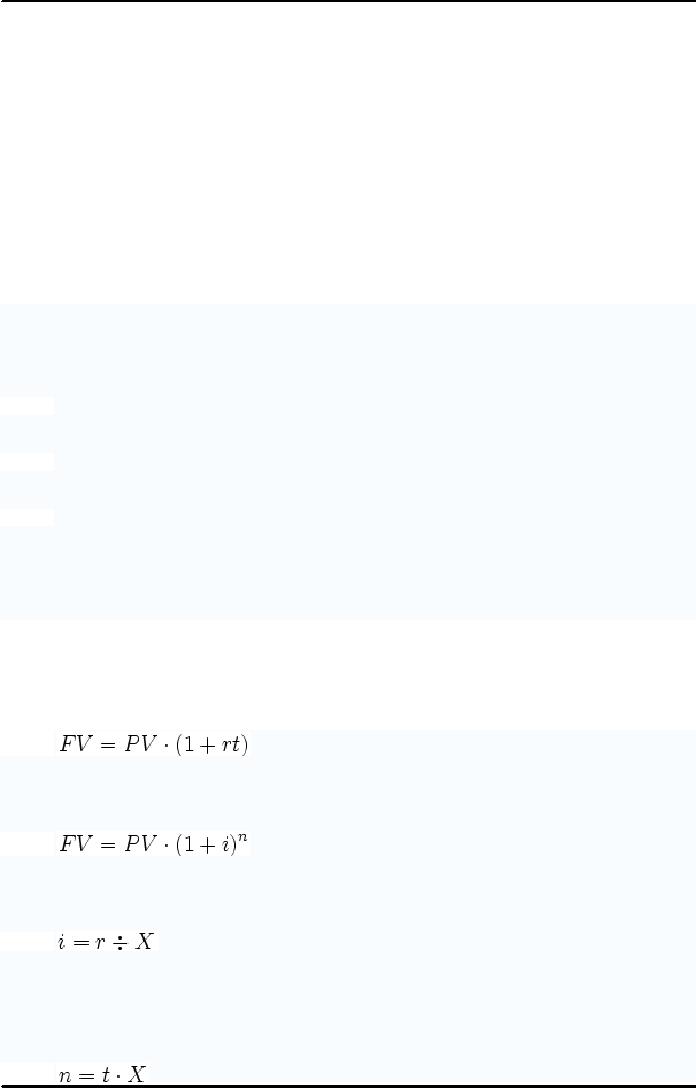 |
TIME VALUE OF MONEY |
| << COMPARISON OF FINANCIAL STATEMENTS |
| Discounted Cash Flow, Effective Annual Interest Bond Valuation - introduction >> |

Corporate
Finance FIN 622
VU
Lesson
03
TIME VALUE OF
MONEY
Time
Value of Money offers an
overview of the information required to
calculate the future and
present
values
of individual cash flows, ordinary
annuities, due perpetuities and
investments with uneven cash
flows.
TVM is
based on the concept that a
dollar that you have today
is worth more than the
promise or
expectation
that you will receive a
dollar in the future. Money
that you hold today is worth
more because
you
can invest it and earn
interest. After all, you should
receive some compensation
for foregoing
spending.
This
hand out has been divided
into following topics, which
will be explained in detail:
1.
PRESENT VALUE
2.
FUTURE VALUE
3.
ANNUITIES
4.
PERPETUITY
PRESENT
VALUE
The
present value of a future
cash flow is the nominal amount of
money to change hands at
some future
date,
discounted to account for the time
value of money. A given amount of money
is always more
valuable
sooner
than later because this enables
one to take advantage of investment
opportunities.
The
present value of delayed
payoff may be found by
multiplying the payoff by a discount
factor which is
less
than 1. If C1 denotes the expected
payoff at period 1,
then
Present
Value (PV) = discount factor. C1
This
discount factor is the value today of $1
received in the future. It is usually
expressed as the reciprocal
of 1
plus a rate of
return.
Discount
Factor = 1 / 1+r
The
rate of return r is the reward
that investors demand for
accepting delayed
payment.
The
present value formula may be
written as follow:
PV = 1 /
1+r. C1
To
calculate present value, we discount
expected payoffs by the rate of return
offered by equivalent
investment
alternatives in the capital market. This
rate of return is often referred to a the
discount rate,
hurdle
rate or opportunity cost of
capital. If the opportunity cost is 5
percent expected payoff is
$200,000,
the
present value is calculated as
follows:
PV =
200,000 / 1.05 =
$190,476
FUTURE
VALUE
Future
value measures what money is
worth at a specified time in the future
assuming a certain interest
rate.
This
is used in time value of money
calculations.
To
determine future value (FV)
without compounding:
Where
PV
is
the present value or principal,
t
is
the time in years, and r
stands
for the per annum
interest
rate.
To
determine future value when
interest is compounded:
Where
PV
is
the present value, n
is
the number of compounding periods, and
i
stands
for the interest rate
per
period.
The
relationship between i
and
r
is:
Where
X
is
the number of periods in one year. If
interest is compounded annually, X
=
1. If interest is
compounded
semiannually, X
=
2. If interest is compounded quarterly, X
=
4. If interest is compounded
monthly,
X
=
12 and so on. This works for
everything except compounded continuously, which
must be
handled
using exponential.
Similarly, the
relationship between n
and
t
is:
13

Corporate
Finance FIN 622
VU
For
example, what is the future value of 1
money unit in one year,
given 10% interest? The number of
time
periods
is 1, the discount rate is 0.10, the
present value is 1 unit, and
the answer is 1.10 units. Note
that this
does
not mean that the holder of
1.00 unit will automatically
have 1.10 units in one year,
it means that
having
1.00 unit now is the equivalent of having
1.10 units in one
year.
ANNUITY
An
annuity is an equal, annual
series of cash flows. Annuities
may be equal annual
deposits, equal
annual
withdrawals,
equal annual payments, or
equal annual receipts. The
key is equal,
annual cash
flows. Annuities
work
in the following way.
Illustration:
Assume
annual deposits of $100
deposited at end of year
earning 5% interest for
three years.
Year 1:
$100 deposited at end of
year
=
$100.00
Year 2:
$100 � .05 = $5.00 + $100 +
$100 = $205.00
Year 3:
$205 � .05 = $10.25 + $205 +
$100 = $315.25
There
are tables for working
with annuities. Future Value
of Annuity Factors is the table to be
used in
calculating
annuities due. Just look up
the appropriate number of periods, locate the
appropriate interest,
take
the factor found and
multiply it by the amount of the annuity.
For
instance, on the three-year 5% interest
annuity of $100 per year.
Going down three years,
out to 5%,
the
factor of 3.152 is found.
Multiply that by the annuity of
$100 yields a future value
of $315.20.
The
present value of annuity can
be finding out by the following
formula:
Present
value of annuity = C
[1/r-1/r(1+r)t]
The
expression in brackets is the annuity
factor, which is the present value at
discount rate r of an annuity
of $1 paid at the
end of each of t
periods.
PEPETUITY
Perpetuity is a
cash flow without a fixed
time horizon.
For
example if someone were
promised that they would
receive a cash flow of $400
per year until they
died,
that
would be perpetuity. To find the
present value of a perpetuity, simply
take the annual return in
dollars
and
divide it by the appropriate discount
rate.
The
present value of perpetuity
can be finding out by the
following formula:
Present
value of perpetuity=C/r
Where
C is the annual return in dollars and r
is the discount rate.
Illustration:
If
someone were promised a cash
flow of $400 per year
until they died and they could earn 6% on
other
investments
of similar quality, in present
value terms the perpetuity
would be worth
$6,666.67.
Present
value of perpetuity= ($400 /
.06 = $6,666.67)
14
Table of Contents:
- INTRODUCTION TO SUBJECT
- COMPARISON OF FINANCIAL STATEMENTS
- TIME VALUE OF MONEY
- Discounted Cash Flow, Effective Annual Interest Bond Valuation - introduction
- Features of Bond, Coupon Interest, Face value, Coupon rate, Duration or maturity date
- TERM STRUCTURE OF INTEREST RATES
- COMMON STOCK VALUATION
- Capital Budgeting Definition and Process
- METHODS OF PROJECT EVALUATIONS, Net present value, Weighted Average Cost of Capital
- METHODS OF PROJECT EVALUATIONS 2
- METHODS OF PROJECT EVALUATIONS 3
- ADVANCE EVALUATION METHODS: Sensitivity analysis, Profitability analysis, Break even accounting, Break even - economic
- Economic Break Even, Operating Leverage, Capital Rationing, Hard & Soft Rationing, Single & Multi Period Rationing
- Single period, Multi-period capital rationing, Linear programming
- Risk and Uncertainty, Measuring risk, Variability of return–Historical Return, Variance of return, Standard Deviation
- Portfolio and Diversification, Portfolio and Variance, Risk–Systematic & Unsystematic, Beta – Measure of systematic risk, Aggressive & defensive stocks
- Security Market Line, Capital Asset Pricing Model – CAPM Calculating Over, Under valued stocks
- Cost of Capital & Capital Structure, Components of Capital, Cost of Equity, Estimating g or growth rate, Dividend growth model, Cost of Debt, Bonds, Cost of Preferred Stocks
- Venture Capital, Cost of Debt & Bond, Weighted average cost of debt, Tax and cost of debt, Cost of Loans & Leases, Overall cost of capital – WACC, WACC & Capital Budgeting
- When to use WACC, Pure Play, Capital Structure and Financial Leverage
- Home made leverage, Modigliani & Miller Model, How WACC remains constant, Business & Financial Risk, M & M model with taxes
- Problems associated with high gearing, Bankruptcy costs, Optimal capital structure, Dividend policy
- Dividend and value of firm, Dividend relevance, Residual dividend policy, Financial planning process and control
- Budgeting process, Purpose, functions of budgets, Cash budgets–Preparation & interpretation
- Cash flow statement Direct method Indirect method, Working capital management, Cash and operating cycle
- Working capital management, Risk, Profitability and Liquidity - Working capital policies, Conservative, Aggressive, Moderate
- Classification of working capital, Current Assets Financing – Hedging approach, Short term Vs long term financing
- Overtrading – Indications & remedies, Cash management, Motives for Cash holding, Cash flow problems and remedies, Investing surplus cash
- Miller-Orr Model of cash management, Inventory management, Inventory costs, Economic order quantity, Reorder level, Discounts and EOQ
- Inventory cost – Stock out cost, Economic Order Point, Just in time (JIT), Debtors Management, Credit Control Policy
- Cash discounts, Cost of discount, Shortening average collection period, Credit instrument, Analyzing credit policy, Revenue effect, Cost effect, Cost of debt o Probability of default
- Effects of discounts–Not effecting volume, Extension of credit, Factoring, Management of creditors, Mergers & Acquisitions
- Synergies, Types of mergers, Why mergers fail, Merger process, Acquisition consideration
- Acquisition Consideration, Valuation of shares
- Assets Based Share Valuations, Hybrid Valuation methods, Procedure for public, private takeover
- Corporate Restructuring, Divestment, Purpose of divestment, Buyouts, Types of buyouts, Financial distress
- Sources of financial distress, Effects of financial distress, Reorganization
- Currency Risks, Transaction exposure, Translation exposure, Economic exposure
- Future payment situation – hedging, Currency futures – features, CF – future payment in FCY
- CF–future receipt in FCY, Forward contract vs. currency futures, Interest rate risk, Hedging against interest rate, Forward rate agreements, Decision rule
- Interest rate future, Prices in futures, Hedging–short term interest rate (STIR), Scenario–Borrowing in ST and risk of rising interest, Scenario–deposit and risk of lowering interest rates on deposits, Options and Swaps, Features of opti
- FOREIGN EXCHANGE MARKET’S OPTIONS
- Calculating financial benefit–Interest rate Option, Interest rate caps and floor, Swaps, Interest rate swaps, Currency swaps
- Exchange rate determination, Purchasing power parity theory, PPP model, International fisher effect, Exchange rate system, Fixed, Floating
- FOREIGN INVESTMENT: Motives, International operations, Export, Branch, Subsidiary, Joint venture, Licensing agreements, Political risk